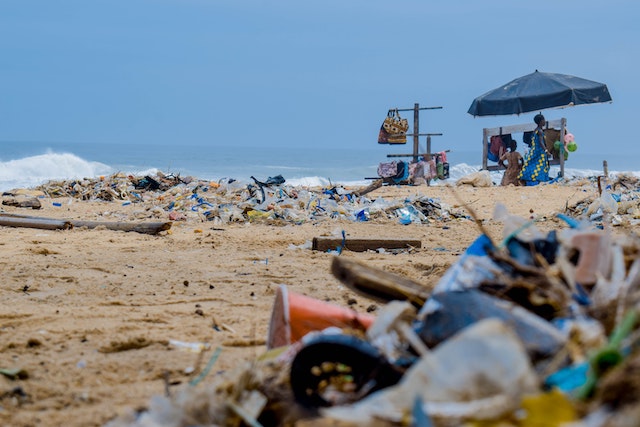A Commotion in our Oceans – How the Fast Fashion Industry is Destroying our Planet
Who would’ve thought that the fashion industry is one of the most polluting industries in the world? As much as I love the topic of It’s a shame to say, but it is the hard truth that we need to accept and do something about. The fashion and textile world make up one of the largest polluters for our planet and is ranked fourth in terms of the negative environmental impact that it has. Something so simple as the everyday clothes we wear is having such a destructive effect on the planet we live on.
By now we should all be aware about the plastic crisis that is polluting our oceans, but what you may be surprised about is our clothes are also contributing to this disaster. Nylon, acrylic, polyester and polyamide – all of these forms of plastic are found present in our clothing. In fact, over 60 percent of the materials in our garments are made up of these plastics and synthetic fibres [1]. The thing is, every time we wash our clothes, it sheds millions of tiny pieces of plastic microfibres. With threads so small they end up draining out of our washing machines then pass through water treatment plants and into the sea.

Not only is it adding to the plastic problem in our oceans, but these small fibres contribute to the environment in another subtle yet pervasive way. They’re adding to the pollution that’s accumulating in the food chain, being ingested by all sorts of small marine wildlife [2]. A recent study found around 73 percent of fish caught at mid ocean depths in the Northwest Atlantic had microplastics in their stomachs – let’s face it, no one wants to be eating their clothes [3].
Fast fashion disregards the production of high quality and durable clothing, in favour of using cheap materials that can be easily mass produced. The business model is based upon knocking off styles from high end fashion shows and recreating them at a lower cost to fit the current trends of fashion, that will most likely be out of vogue the following season. This process encourages us to stay up to date by buying the latest clothes in order to stay ‘on trend’. However, this is having a detrimental effect on to our planet – it’s slowly eating away at our environment. A lot of the time, when we get bored of these clothes, we end up throwing them away. The biggest problem with this is that it leads to enormous quantities of clothing ending up being burned in incinerators or taken to landfill where they release methane. Every year, 350,000 tonnes, that’s around £140 million worth of used but still wearable clothing goes to landfill in the UK and this figure is still too high [4].

So, what can I can do to reduce the amount of pollution that clothing creates you ask?
- First of all, instead of throwing clothes out and letting them build up in landfill, ask around and see if any of your friends or family are interested in taking them off you. If not, then taking unwanted clothes to charity should be your next option and it couldn’t be any easier now. A lot of charities now even allow for individual picks ups with hassle free collection as they understand that it will benefit both the charities and the planet all in one go.
- As easy as it is to take clothes to charity shops, buying from them is an even better solution. Not only are you giving money back to the charity, you’re also helping the environment as buying clothes second hand is a more sustainable option than buying clothes new. It allows you to repurpose neglected clothes and give them a new home to show them the love that they once had again (for an even lower cost). Kilo sales and sites like Depop and eBay are another great way to obtain clothes in a renewable fashion. Often you can even find vintage gems that not only look stylish but cost a fraction of the price of what they would normally retail at.
- Plastic free clothing is another way to help reduce the impact the fashion industry has on the environment. Although they might be slightly more expensive, brands like Loomstate, Plant Faced and Miakoda offer a vegan, plastic free alternative that are made from materials that are either 100% organic cotton or plant based. Buying clothes from these brands will stop the pollution that’s entering our oceans through washing clothes
Clothing gives us all a sense of identy, but why should we let it destroy our planets? We live on this earth as if we have another one to go to – but we don’t. It’s not hard to swap out small lifestyle choices in order to make a difference. Truthfully, we should all be conscious of the demon that’s living in our wardrobes.
References
[1] https://friendsoftheearth.uk/plastics/microfibres-plastic-in-our-clothes
[2] https://www.vox.com/the-goods/2018/9/19/17800654/clothes-plastic-pollution-polyester-washing-machine
[3] https://www.ecowatch.com/plastics-deep-sea-fish-2536726086.html
[4] https://clothesaid.co.uk/about-us/facts-on-clothes-recycling/